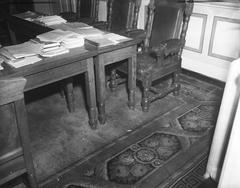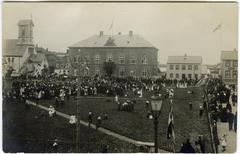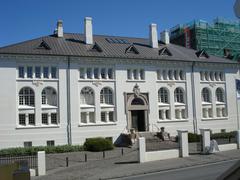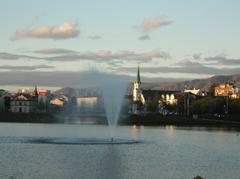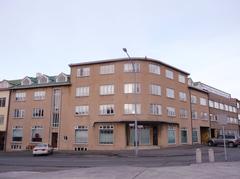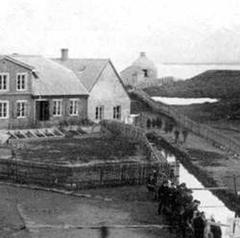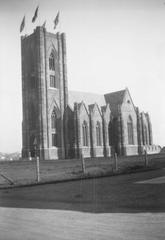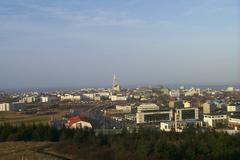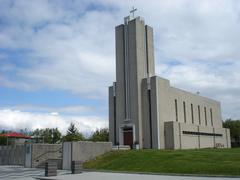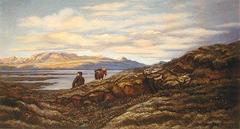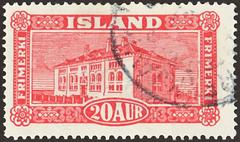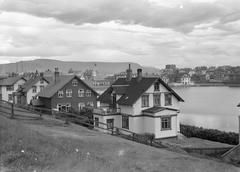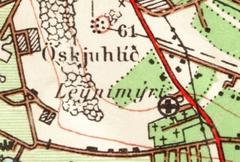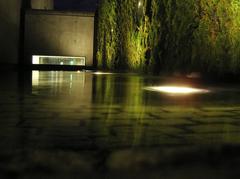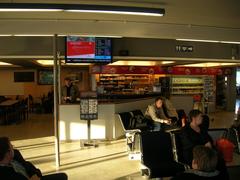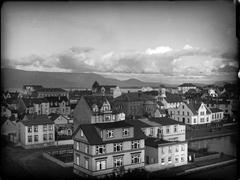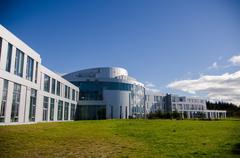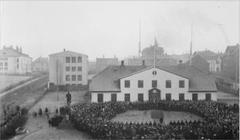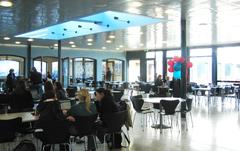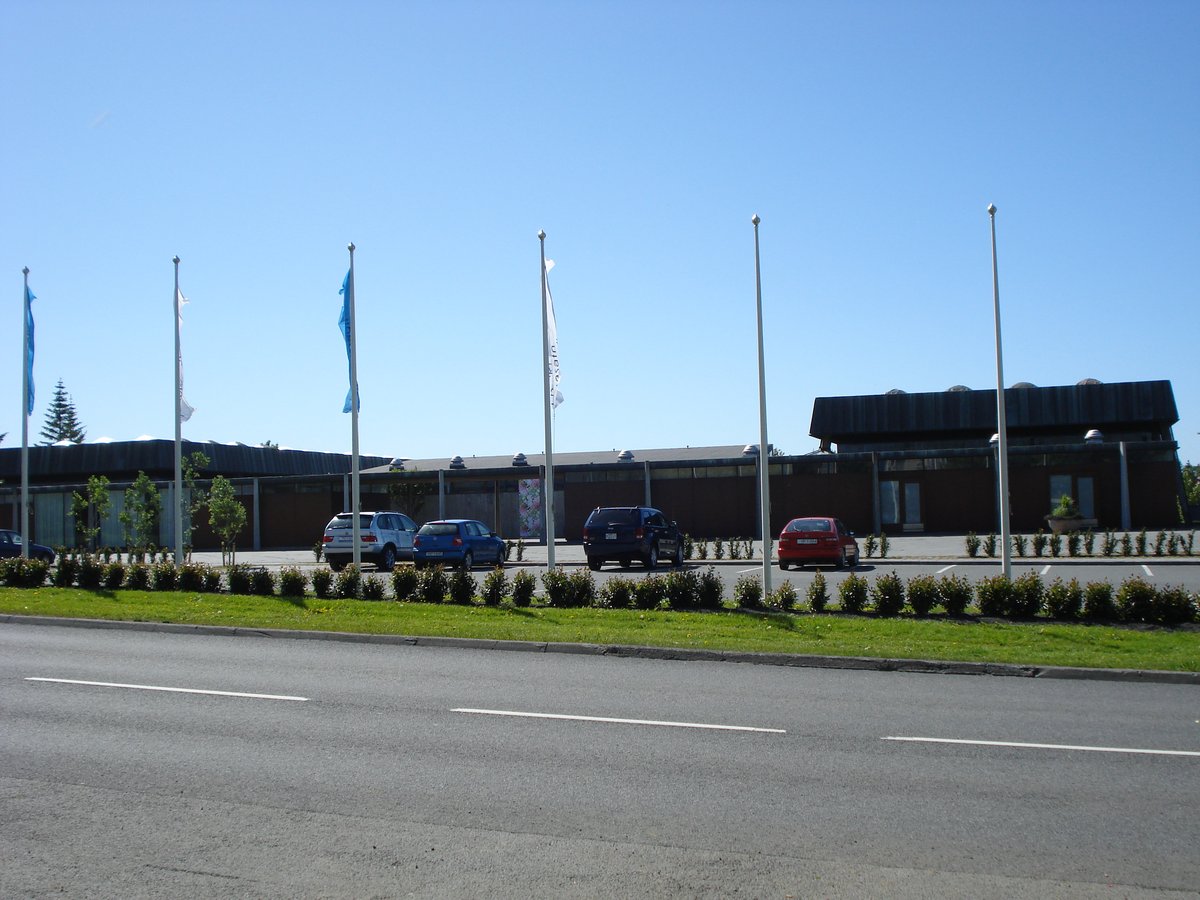
Kjarvalsstaðir Visiting Hours Tickets and Guide to Reykjavík Historical Sites
Date: 04/07/2025
Introduction to Kjarvalsstaðir and Its Cultural Significance
Nestled within the tranquil expanse of Klambratún Park in Reykjavík, Kjarvalsstaðir stands as a distinguished cultural landmark that offers visitors an immersive journey into Icelandic modern art and national identity. Established in 1973 as the first Icelandic building dedicated exclusively to art exhibitions, this museum honors the legacy of Jóhannes Sveinsson Kjarval (1885–1972), one of Iceland’s most influential painters whose works intimately explore the mystical landscapes and folklore of the country. Kjarvalsstaðir combines Nordic modernist architectural elegance—with its striking use of raw materials and expansive floor-to-ceiling windows—with a serene natural setting, creating an environment that harmonizes art, nature, and culture. Visitors can explore a rich permanent collection of over 17,000 artworks, featuring Kjarval’s evocative paintings alongside rotating exhibitions of Icelandic and international modern art. Practical details such as visiting hours, ticketing, accessibility, and special events are thoughtfully designed to enhance the visitor experience. Moreover, the museum’s proximity to other Reykjavík historical sites, including Reykjavík City Hall and the National Museum of Iceland, makes it an essential stop for those eager to delve into the artistic and cultural heritage of Iceland’s capital. Whether you are an art enthusiast, a history buff, or a casual traveler, Kjarvalsstaðir offers a captivating encounter with Icelandic creativity and identity in a uniquely inviting setting (museumguide.is, listasafnreykjavikur.is, visitreykjavik.is).
Contents Overview of Visiting Kjarvalsstaðir and Related Information
- Introduction
- Origins and Architectural Context
- Jóhannes S. Kjarval: Life and Legacy
- The Museum’s Collection and Growth
- Visiting Kjarvalsstaðir: Hours, Tickets, and Accessibility
- Special Events, Guided Tours, and Photographic Spots
- Nearby Attractions: Exploring Reykjavík Historical Sites
- Cultural Significance and National Identity
- Community Engagement and Educational Role
- Preservation of Artistic Heritage
- FAQ
- Conclusion and Call to Action
Introduction
Kjarvalsstaðir is not only a cornerstone of Icelandic art but also a must-visit cultural landmark in Reykjavík. Located in the tranquil Klambratún Park, it offers visitors a unique opportunity to experience the life and legacy of Jóhannes S. Kjarval, one of Iceland’s most influential painters. This article explores Kjarvalsstaðir’s historical background, cultural significance, practical visitor information including visiting hours and ticket details, and nearby Reykjavík historical sites to help you plan a memorable visit.
Origins and Architectural Context
Kjarvalsstaðir, situated at Flókagata 24 in Reykjavík, holds a significant place in Icelandic cultural history. Opened in 1973, it was the first building in Iceland designed exclusively to display art, marking a milestone in the nation’s dedication to the visual arts (museumguide.is). This Nordic modernist structure is distinguished by clean lines, functional design, and expansive floor-to-ceiling windows that seamlessly integrate the surrounding Klambratún Park into the viewing experience. This architectural harmony underlines the museum’s theme of the interplay between Icelandic nature and artistic expression.
The museum’s setting within Klambratún Park is intentional; the lush grounds and stone-tiled courtyard provide a peaceful backdrop that complements the themes prevalent in Kjarval’s works. Designed to maximize natural light and openness, the building enhances the viewer’s connection with Kjarval’s art, which often draws inspiration from Iceland’s dramatic landscapes (icelandictimes.com).
Jóhannes S. Kjarval: Life and Legacy
Jóhannes Sveinsson Kjarval (1885–1972) is celebrated as one of Iceland’s most beloved and influential artists. Born into poverty in the remote Eastfjords, his upbringing was shaped by hardship and resilience (klausturiceland.is). Despite these challenges, Kjarval’s talent was nurtured by his family and community, allowing him to pursue art alongside his early work as a fisherman.
Kjarval’s artistic education included mentorship under prominent Icelandic painters and formal studies at the Royal Danish Academy of Fine Arts in Copenhagen, where he absorbed Impressionist, Expressionist, and Cubist influences (en.wikipedia.org). Returning to Iceland in 1922, Kjarval introduced a modernist style that transformed Icelandic art. His prolific output—spanning thousands of paintings and drawings—explores Icelandic landscapes, mythology, and symbolic natural elements, fostering a new national appreciation for the country’s environment (listasafnreykjavikur.is).
The Museum’s Collection and Growth
Originally created to exhibit Kjarval’s donated works, Kjarvalsstaðir’s collection has expanded to include over 17,000 registered artworks (icelandictimes.com). The permanent collection offers a comprehensive view of Kjarval’s artistic evolution, from impressionistic landscapes to abstract and fantastical compositions.
In addition to Kjarval’s oeuvre, the museum hosts rotating exhibitions showcasing Icelandic and international modern art, such as the “Kaleidoscope: Icelandic 20th Century Art” exhibition, which featured around 200 pieces for the museum’s 50th anniversary. These exhibitions ensure Kjarvalsstaðir remains an active participant in the ongoing narrative of Icelandic art.
Visiting Kjarvalsstaðir: Hours, Tickets, and Accessibility
Planning your visit to Kjarvalsstaðir is straightforward. The museum is open Tuesday through Sunday, from 11:00 AM to 5:00 PM, and closed on Mondays and public holidays. Admission prices are reasonable, with standard tickets available for 1,000 ISK, while children under 18, students, and senior citizens enjoy discounted rates. Entry is free for children under 12 and on the first Thursday of each month.
Kjarvalsstaðir is wheelchair accessible and provides facilities for visitors with disabilities. The museum’s café and design-and-book store offer comfortable spaces for relaxation and shopping.
For the latest information on visiting hours and ticketing, check the official Reykjavík Art Museum website or contact the museum directly.
Special Events, Guided Tours, and Photographic Spots
Kjarvalsstaðir hosts a variety of special events throughout the year, including artist talks, workshops, and cultural festivals that coincide with Reykjavík’s city-wide celebrations such as Culture Night and the Winter Festival (reykjavik.is). Guided tours are available in multiple languages and provide in-depth insights into Kjarval’s life and works, enhancing the visitor experience.
Photographers and art lovers will find the museum’s architecture and surrounding park ideal for capturing stunning images. The expansive windows frame views of Klambratún Park, offering natural lighting that changes beautifully throughout the day.
Nearby Attractions: Exploring Reykjavík Historical Sites
While visiting Kjarvalsstaðir, take the opportunity to explore nearby Reykjavík historical sites. The adjacent Klambratún Park is perfect for a leisurely stroll. Within walking distance are landmarks such as the Reykjavík City Hall and the National Museum of Iceland, both rich in cultural heritage. This makes Kjarvalsstaðir a central stop in any itinerary focused on Reykjavík’s artistic and historical offerings.
Cultural Significance and National Identity
As part of the Reykjavík Art Museum network, Kjarvalsstaðir plays a pivotal role in preserving Iceland’s artistic heritage (visiticeland.com). Kjarval’s influence extends beyond painting; his work has shaped Icelandic national identity by portraying the mystical qualities of the landscape, inspiring writers and artists alike (eldsveitir.is).
The museum’s exhibitions often explore themes of nature, mythology, and the interplay between tradition and modernity, offering visitors a profound understanding of Icelandic culture.
Community Engagement and Educational Role
Kjarvalsstaðir is a vibrant cultural hub offering guided tours, workshops, and educational programs tailored to diverse audiences (visiticeland.com). Its café and bookshop provide welcoming spaces for visitors to reflect and engage further with Icelandic art.
Preservation of Artistic Heritage
The museum’s extensive collection and commitment to digitization ensure the preservation and accessibility of Icelandic art for future generations (icelandictimes.com). This aligns with modern museum practices and reinforces Kjarvalsstaðir’s leadership in Icelandic art conservation.
FAQ
Q: What are the opening hours of Kjarvalsstaðir? A: Open Tuesday to Sunday, 11:00 AM to 5:00 PM. Closed Mondays.
Q: How much are tickets? A: Standard admission is 1,000 ISK, with discounts for students, seniors, and free entry for children under 12.
Q: Is Kjarvalsstaðir wheelchair accessible? A: Yes, the museum is fully accessible.
Q: Are guided tours available? A: Yes, guided tours are offered in multiple languages.
Q: Can I visit other historical sites near Kjarvalsstaðir? A: Yes, nearby attractions include Klambratún Park, Reykjavík City Hall, and the National Museum of Iceland.
Conclusion and Call to Action
Kjarvalsstaðir is a vital cultural destination that offers rich insights into Icelandic art, history, and identity. Whether you are an art enthusiast or a casual visitor, it provides a captivating experience with its blend of architecture, natural surroundings, and profound artistic legacy. Plan your visit today to explore this Reykjavík historical site — check current visiting hours and ticket information, join a guided tour, and immerse yourself in the world of Jóhannes S. Kjarval.
For more travel tips and updates on Icelandic art and culture, download the Audiala app, explore related posts, and follow us on social media.
Introduction
Kjarvalsstaðir is a premier art museum in Reykjavík, Iceland, renowned for its striking Nordic modernist architecture and its unique integration with Klambratún Park. This guide covers everything you need to know about visiting Kjarvalsstaðir, including architectural highlights, visitor information such as visiting hours and ticket prices, travel tips, and nearby attractions. Whether you’re an architecture enthusiast or an art lover, this museum offers an enriching cultural experience in the heart of Reykjavík.
Architectural Design and Features
Nordic Modernism and Influences
Kjarvalsstaðir stands as a landmark of Nordic modernism in Icelandic architecture, designed by Hannes Kr. Davíðsson and inaugurated in 1973 (listasafnreykjavikur.is). The building was the first in Iceland specifically constructed for public art exhibitions, reflecting Reykjavík’s growing cultural aspirations in the mid-20th century (en.wikipedia.org). Davíðsson’s design draws inspiration from both Japanese and Nordic architectural traditions, emphasizing simplicity, natural materials, and a harmonious relationship with the surrounding environment (listasafnreykjavikur.is).
Key elements of the building’s style include:
- Raw Natural Materials: The structure features unfinished or raw concrete walls, where the grain of the concrete mold remains visible, lending a tactile, organic quality to the surfaces. The exterior is clad in Corten steel, which has been allowed to weather naturally, creating a warm, rusted patina that glows in sunlight (listasafnreykjavikur.is).
- Lightness and Transparency: The building’s support structure consists of slender columns that carry a horizontal, copper-clad roof. This allows for non-load-bearing walls, resulting in open, flexible gallery spaces. Interior columns project diagonally through glass skylights, further enhancing the sense of lightness and connection to the outdoors (listasafnreykjavikur.is).
- Floor-to-Ceiling Windows: Expansive windows line the southern side of the building, offering panoramic views of Klambratún Park and flooding the interior with natural light. This design blurs the boundary between the museum’s interior and the surrounding landscape, creating a tranquil, contemplative atmosphere ideal for viewing art (visitreykjavik.is).
Layout and Spatial Organization
The museum is organized as a pavilion with two main wings enclosing a central courtyard, joined by a slender connecting wing. The layout is intentionally oriented to maximize sunlight and views over the park, while remaining relatively closed to the north and the street, ensuring privacy and serenity for visitors (listasafnreykjavikur.is).
- Single-Level Accessibility: The entire museum is on a single ground floor, making it highly accessible for all visitors, including those with mobility challenges (listasafnreykjavikur.is).
- Flexible Exhibition Spaces: The open-plan galleries are designed to accommodate both large-scale paintings and sculptures, as well as more intimate installations. Benches and portable chairs are available throughout, allowing visitors to linger and reflect (listasafnreykjavikur.is).
- Central Social Hub: The central area, adjacent to the café and reception, serves as a lively gathering space, while the exhibition halls themselves remain quiet and contemplative (listasafnreykjavikur.is).
Detailing and Materiality
Attention to detail is evident throughout the building:
- Horizontal Accents: Exterior horizontal lines above the windows echo the roofline, visually unifying the structure.
- Innovative Use of Materials: The combination of concrete, Corten steel, and glass creates a dialogue between solidity and transparency, warmth and coolness, tradition and innovation (listasafnreykjavikur.is).
- Natural Light: Skylights and large windows ensure that daylight animates the interior, changing the mood of the galleries throughout the day and across seasons (guidetoiceland.is).
Setting: Klambratún Park and Urban Context
Integration with Klambratún Park
Kjarvalsstaðir is uniquely situated within Klambratún Park, one of Reykjavík’s few recreational areas intentionally designed as part of the city’s artistic and cultural landscape (listasafnreykjavikur.is). The park and museum were conceived together in the 1960s, with the museum positioned at the northern edge of the park to maximize its relationship with the green space.
- Park Features: Klambratún is a vast public park popular for cultural events, sports, and leisure. It offers open lawns, playgrounds, disc golf, and walking paths, making it a favorite spot for both locals and tourists (guidetoiceland.is).
- Views and Ambience: The museum’s southern façade opens directly onto the park, with floor-to-ceiling windows providing uninterrupted views of the greenery. This setting creates a peaceful, restorative environment for art appreciation (visitreykjavik.is).
Urban Surroundings
Kjarvalsstaðir lies at the intersection of three mid-20th-century neighborhoods—Hlíðar, Rauðará, and Norðurmýri—characterized by low-rise, homogeneous residential buildings. The museum’s location, just a short walk from Reykjavík’s city center, makes it easily accessible while offering a retreat from urban bustle (listasafnreykjavikur.is).
- Transport and Access: The museum is well-served by public transport, with three bus stops nearby and easy access for cyclists and pedestrians. The terrain is flat and suitable for visitors with mobility needs (guidetoiceland.is).
- Parking: There are dedicated parking spaces, including two for disabled visitors directly in front of the main entrance (listasafnreykjavikur.is).
Visitor Information
Kjarvalsstaðir Visiting Hours
- Opening Hours:
- Monday to Sunday: 11:00 AM – 5:00 PM
- Closed on certain public holidays; check the official website before visiting (listasafnreykjavikur.is).
Tickets and Admission
- Entry Fee: Admission to Kjarvalsstaðir is free, making it an accessible cultural destination for all visitors (listasafnreykjavikur.is).
- Guided Tours: Guided tours are available upon request, including specialized tours for visitors with visual and hearing impairments (listasafnreykjavikur.is). Booking in advance is recommended.
Special Events and Exhibitions
Kjarvalsstaðir hosts rotating temporary exhibitions, concerts, workshops, and community events throughout the year. Notable events include:
- Europe Day Cultural Festival: Annual celebrations featuring music and art performances (allevents.in).
- Family Activity Sessions: Creative workshops in the Idea Lab adjacent to the café.
Check the museum’s website or social media channels for the latest schedule.
Travel Tips
- Best Time to Visit: Late spring through early autumn offers pleasant weather and extended daylight, enhancing your experience of the museum and park.
- Getting There: Kjarvalsstaðir is a 15-minute walk from Reykjavík city center. Use public buses that stop nearby or cycle along well-maintained paths. The area is flat and pedestrian-friendly.
- Accessibility: The museum is fully accessible to wheelchair users and visitors with mobility challenges.
Nearby Attractions
While visiting Kjarvalsstaðir, consider exploring these nearby Reykjavik historical sites and cultural venues:
- Reykjavík Art Museum (Ásmundarsafn and Hafnarhús locations): Other branches showcasing Icelandic and international art.
- Hallgrímskirkja Church: Iconic Reykjavík landmark with panoramic city views.
- Harpa Concert Hall: Architectural marvel and cultural hub near the harbor.
Internal links to related articles on Reykjavik museums and Icelandic art are available on our website to help plan your itinerary.
Visitor Experience: Atmosphere and Amenities
Interior Ambience
The museum’s interior is spacious, light-filled, and tranquil, designed to foster contemplation and relaxation. The interplay of natural materials, daylight, and views of the park creates a unique atmosphere that distinguishes Kjarvalsstaðir from more conventional urban museums (travellersstays.com).
- Quiet Spaces: Exhibition halls are intentionally quiet, while the central area near the café is more vibrant. The museum regularly offers special opening hours with adjusted stimuli for visitors with sensory processing needs (listasafnreykjavikur.is).
- Café and Social Spaces: The museum café, Klambrar Bistrø, is a popular spot for both locals and tourists, offering homemade dishes, cakes, and a variety of teas and coffees. The café is surrounded by plants and art, with seating that overlooks the park through the expansive windows (travellersstays.com).
- Family and Creative Facilities: The Idea Lab, a family-activity space adjacent to the café, provides books, magazines, and creative materials for children and families, making the museum welcoming for visitors of all ages (listasafnreykjavikur.is).
Accessibility and Inclusivity
Kjarvalsstaðir is committed to accessibility, with features including:
- Step-Free Access: Ramps are available at the main entrance and between the café and courtyard. The single-level layout ensures easy navigation for wheelchair users (listasafnreykjavikur.is).
- Accessible Facilities: Wheelchairs are available to borrow, and benches or portable chairs are provided in all exhibition halls. Guide dogs are welcome, and guided tours are offered for blind, visually impaired, and hearing-impaired visitors (listasafnreykjavikur.is).
- Restrooms and Amenities: Accessible toilets are provided, and the museum shop offers books and souvenirs related to Icelandic art and culture (joeyisatraveler.com).
Outdoor and Recreational Opportunities
The museum’s integration with Klambratún Park extends the visitor experience beyond the galleries:
- Picnicking: While there are no indoor picnic facilities, visitors are welcome to enjoy their own food in the park when weather permits (listasafnreykjavikur.is).
- Events and Activities: The park hosts cultural and sports events, and the museum itself occasionally features concerts and community gatherings (allevents.in).
FAQ
Q: What are the Kjarvalsstaðir visiting hours? A: The museum is open daily from 11:00 AM to 5:00 PM. It is closed on some public holidays.
Q: Is there an admission fee? A: Admission to Kjarvalsstaðir is free.
Q: Are guided tours available? A: Yes, guided tours can be booked in advance, including tours tailored for visitors with disabilities.
Q: Is the museum accessible for wheelchair users? A: Yes, the museum offers step-free access, ramps, and wheelchair availability.
Q: Can I bring children? A: Absolutely. The Idea Lab offers family-friendly activities and creative materials.
Q: Are there parking facilities? A: Yes, including two designated disabled parking spots near the main entrance.
Visuals and Media Suggestions
- Include high-quality photos of the museum’s exterior showcasing the Corten steel façade and floor-to-ceiling windows with views of Klambratún Park (alt text: “Kjarvalsstaðir museum exterior with Corten steel and park view”).
- Interior images highlighting natural light, gallery spaces, and the café (alt text: “Interior of Kjarvalsstaðir art museum with natural light and artworks”).
- A map showing the location relative to central Reykjavík and nearby attractions.
- Video tour or 360-degree views of the museum’s interior and park setting.
Conclusion and Call to Action
Kjarvalsstaðir is a must-visit destination for anyone interested in Icelandic art, architecture, and culture. Its seamless blend of modernist design, natural surroundings, and visitor-friendly amenities makes it a unique cultural gem in Reykjavík. Plan your visit today to experience the tranquil galleries, engaging exhibitions, and beautiful park setting.
For the latest updates on visiting hours, special events, and guided tours, download the Audiala app. Explore more about Reykjavik’s museums and Icelandic art by browsing our related posts, and follow us on social media to stay connected with the vibrant Icelandic art scene.
Discover Kjarvalsstaðir: Reykjavik’s Premier Art Museum Showcasing Icelandic Modernism
Located adjacent to the serene Klambratún Park, Kjarvalsstaðir is a cornerstone of Reykjavik historical sites and a must-visit destination for art lovers exploring Iceland. Renowned for its dedication to Jóhannes S. Kjarval, one of Iceland’s most beloved artists, the museum offers visitors a rich experience through permanent collections, rotating exhibitions, educational programs, and community events. This comprehensive guide covers everything you need to know about Kjarvalsstaðir visiting hours, tickets, exhibitions, and more.
Permanent Collections at Kjarvalsstaðir
Kjarvalsstaðir’s permanent collection celebrates the life and work of Jóhannes S. Kjarval (1885–1972), whose expressive landscapes and mystical interpretations of Icelandic nature and folklore have made him a cultural icon. His paintings and drawings form the heart of the museum’s collection, reflecting Icelandic identity and the evolution of 20th-century art (listasafnreykjavikur.is).
Beyond Kjarval, the museum features works by prominent Icelandic and international modern artists, including Hildur Hákonardóttir and Hekla Dögg Jónsdóttir. These collections provide a broad overview of Iceland’s modern art scene and its ongoing dialogue with contemporary artistic movements (icelandicartcenter.is).
Temporary and Rotating Exhibitions
Kjarvalsstaðir hosts a dynamic lineup of temporary exhibitions that explore themes of Icelandic culture, nature, and artistic innovation. Recent highlights include:
Notable Exhibitions
- Kjarval and the 20th Century: When Modernity Anchored — Showcasing Kjarval’s influence on Icelandic modern art (icelandicartcenter.is).
- Dreamland — An exploration of the imaginative qualities in Icelandic art, featuring Kjarval and contemporary artists.
- Hildur Hákonardóttir, Red Thread (2023) and Hekla Dögg Jónsdóttir, Null Island (2023) — Exhibitions spotlighting innovative contemporary voices.
Additional recent and upcoming exhibitions include:
- D51 Sadie Cook and Jo Pawlowska: Allt sem ég vil segja þér
- Erró: Remix
- Höfuðskepnur
- Undraland: Halldór Ásgeirsson með verk í vinnslu
- Ragnar Kjartansson: Heimsljós – líf og dauði listamanns
Stay updated on current exhibitions via the official museum website.
Educational Programs and Workshops
Kjarvalsstaðir emphasizes community engagement through diverse educational offerings:
- Guided Tours: In-depth tours focusing on Kjarval’s work and current exhibitions. Group bookings and special tours available (listasafnreykjavikur.is).
- Workshops: Creative sessions for all ages, often tied to ongoing exhibits (icelandguidetours.com).
- Idea Lab (Hugmyndasmiðjan): A family-friendly space with interactive resources and art materials (listasafnreykjavikur.is).
- Accessibility Programs: Sensory-friendly hours, tours for visitors with autism or sensory challenges, sign language tours, and more to ensure inclusivity (listasafnreykjavikur.is).
Community Engagement and Special Events
Visitors can participate in artist talks, lectures, cultural evenings, film screenings, and gallery walks that connect the museum to Reykjavik’s vibrant art scene (icelandguidetours.com).
Facilities Enhancing Your Visit
Designed in Nordic modernist style, Kjarvalsstaðir features floor-to-ceiling windows with views of Klambratún Park, creating a harmonious setting for art appreciation (icelandicartcenter.is).
- Museum Store: Offers art books, prints, and Icelandic design items.
- Café: Open daily 10:00–17:00, with indoor and outdoor seating.
- Accessibility: Single-level building with ramps, automatic doors, wheelchair loan, designated parking, and public transport access (listasafnreykjavikur.is).
- Family Amenities: Stroller storage and loaners, lockers, and cloakrooms.
Practical Information: Visiting Hours, Tickets, and Location
- Visiting Hours: Open daily from 10:00 to 17:00; extended hours until 22:00 on the last Thursday of each month. Holiday hours may vary (listasafnreykjavikur.is).
- Tickets: Standard adult admission is approximately 2,000 ISK (2025 rates), with discounts for students and seniors. Children typically enter free (icelandguidetours.com).
- Location: Flókagata 24, 105 Reykjavík, adjacent to Klambratún Park (icelandicartcenter.is). See the map below for directions.
Interactive Map and Virtual Tour of Kjarvalsstaðir
Frequently Asked Questions (FAQ)
Q: What are Kjarvalsstaðir visiting hours? A: The museum is open daily from 10:00 to 17:00, with extended hours until 22:00 on the last Thursday of each month.
Q: How do I purchase Kjarvalsstaðir tickets? A: Tickets can be bought at the museum entrance or online via the official website. Discounts are available for students and seniors.
Q: Is Kjarvalsstaðir wheelchair accessible? A: Yes, the museum is fully accessible with ramps, automatic doors, accessible restrooms, and loaner wheelchairs.
Q: Are there guided tours available? A: Yes, guided tours are offered regularly and can be booked in advance for groups.
Q: Can I visit Kjarvalsstaðir with children? A: Absolutely! The museum provides family-friendly workshops, the Idea Lab activity space, and amenities such as stroller storage.
Q: Are there any virtual tours available? A: Yes, an interactive virtual tour is available on the museum’s website for remote visitors.
Explore More Reykjavik Historical Sites and Art Museums
For visitors interested in Reykjavik’s rich cultural landscape, consider also exploring the Reykjavik Art Museum – Hafnarhús and the Reykjavik City Museum. These sites offer complementary insights into Iceland’s artistic and historical heritage.
Conclusion
Kjarvalsstaðir stands as an essential Reykjavik historical site and a vibrant hub for Icelandic modern and contemporary art. With its extensive permanent collections, engaging temporary exhibitions, inclusive educational programs, and visitor-friendly facilities, it offers a memorable cultural experience for locals and tourists alike. Plan your visit today to explore the captivating works of Kjarval and other Icelandic artists, enjoy family-friendly activities, and immerse yourself in Reykjavik’s artistic heritage.
Don’t forget to check the latest visiting hours and ticket information on the official Kjarvalsstaðir website before your visit. Follow us on social media for updates on exhibitions and events and download the Audiala app for an enhanced museum experience!
Introduction
Welcome to our comprehensive visitor guide to Kjarvalsstaðir, a key part of the Reykjavík Art Museum network. Whether you’re planning your visit to explore Icelandic modern art, curious about Kjarvalsstaðir visiting hours, or looking for practical information like tickets and accessibility, this article covers everything you need. Discover how to make the most of your trip to this iconic museum nestled in Klambratún Park.
Visitor Experience at Kjarvalsstaðir
The Setting and Atmosphere
Kjarvalsstaðir is renowned for its serene location within Klambratún Park, offering visitors a peaceful escape from Reykjavík’s urban energy. The museum’s Nordic modernist architecture features expansive floor-to-ceiling windows that flood galleries with natural light and frame stunning views of the surrounding greenery (Reykjavík Art Museum - Kjarvalsstaðir). This design creates a harmonious connection between the interior space and Iceland’s unique landscape, honoring Jóhannes S. Kjarval, whose art is inspired by Icelandic nature.
Art Collections and Exhibitions
Kjarvalsstaðir’s core collection centers on Jóhannes S. Kjarval’s works, including paintings and sketches that depict Icelandic landscapes, folklore, and abstract forms. The museum also hosts rotating temporary exhibitions showcasing prominent Icelandic and international modern artists, highlighting the evolution of modern art in Iceland (Reykjavík Art Museum).
Exhibitions feature bilingual Icelandic and English labels, enhancing accessibility for international visitors. Families can enjoy the Idea Lab (Hugmyndasmiðjan), an interactive space encouraging creativity inspired by museum themes (Reykjavík.is).
Amenities and On-Site Services
Café and Dining
Klambrar Bistrø café is open daily from 10:00 to 17:00, offering drinks, pastries, and light meals. Its seating overlooks Klambratún Park, providing a relaxing spot before or after your museum tour (Reykjavík Art Museum - Kjarvalsstaðir).
Museum Store
The museum store in the lobby sells art books, Icelandic design items, prints, and souvenirs, perfect for unique gifts or keepsakes (Triphobo).
Family and Educational Facilities
The Idea Lab offers interactive activities for children and families, while workshops, guided tours, and educational programs are available throughout the year. Visit the museum’s calendar for current events.
Accessibility at Kjarvalsstaðir
Physical Accessibility
Kjarvalsstaðir is wheelchair accessible, with step-free entrances, elevators, and accessible restrooms. Most exhibitions are on a single level, facilitating easy movement (Disability Insider). The museum complies with Icelandic accessibility standards.
Transportation and Parking
- Public Transport: Located at Flókagata 24, 105 Reykjavík, Kjarvalsstaðir is accessible via bus routes 11 and 13 (Iceland the Beautiful). City buses support wheelchair users, though only one wheelchair can be accommodated per bus, requiring coordination with the driver (Disability Insider).
- Parking: Adjacent parking includes designated spaces for disabled visitors.
Additional Accessibility Services
- Accessible Taxis: Reykjavík offers accessible taxis with ramps and space for electric wheelchairs; booking ahead is advised (Disability Insider).
- Accessible Accommodation: Nearby hotels such as Loft Hostel, Grand Hotel Reykjavík, Hilton Reykjavík Nordica, and Icelandair Hotel Marina provide accessible rooms (Disability Insider).
Practical Information for Visitors
Kjarvalsstaðir Visiting Hours
- Regular Hours: Daily from 10:00 to 17:00.
- Extended Hours: Open until 22:00 on the last Thursday of each month.
- Holidays: Closed on Easter Sunday, December 24, 25, 31, and January 1. Open 13:00 to 17:00 on December 26 (Reykjavík.is).
Tickets and Admission
- Ticketing: Admission fees apply. Check the official website for current prices and discounts for students, seniors, and children.
- Combined Tickets: Combined tickets for Kjarvalsstaðir, Hafnarhús, and Ásmundarsafn offer great value for exploring Reykjavík’s art scene (Visit Iceland).
Visitor Flow and Duration
- Peak Times: Most popular from 10:00 to 11:00 AM; early afternoon visits often offer a quieter experience.
- Average Visit: Approximately 1.5 hours (Triphobo).
Facilities
- Accessible restrooms
- Complimentary Wi-Fi
- Cloakroom for coats and bags
Family and Group Visits
- Family-friendly with dedicated spaces and activities
- Guided tours available by booking at [email protected]
Location and Nearby Attractions
- Address: Flókagata 24, 105 Reykjavík, Iceland (Reykjavík Art Museum - Kjarvalsstaðir)
- Nearby Sites: Walking distance to Hallgrímskirkja, The Pearl, and other cultural landmarks (Iceland the Beautiful).
Frequently Asked Questions (FAQ)
Q: What are Kjarvalsstaðir visiting hours? A: The museum is open daily from 10:00 to 17:00, with extended hours until 22:00 on the last Thursday of each month.
Q: How much are Kjarvalsstaðir tickets? A: Admission fees vary; please check the official website for updated prices and discounts.
Q: Is Kjarvalsstaðir wheelchair accessible? A: Yes, the museum offers step-free access, elevators, and accessible restrooms.
Q: Can I take photos inside Kjarvalsstaðir? A: Photography is generally allowed, but flash and tripods may be restricted in some galleries.
Q: Are there guided tours available? A: Yes, guided tours can be booked in advance via email.
Visitor Tips
- Check the museum’s website for current exhibitions and updates on opening hours.
- Combine your visit with a walk or picnic in Klambratún Park.
- The museum operates on a cashless policy; credit and debit cards are accepted.
- Visitors with specific accessibility needs should contact the museum in advance.
Visuals and Interactive Elements
Explore the virtual tour and photo gallery on the official website to preview exhibitions and the museum’s architecture. Look for images with alt text such as “Kjarvalsstaðir visiting hours,” “Kjarvalsstaðir art galleries,” and “Reykjavík Art Museum exterior.”
Conclusion
Kjarvalsstaðir offers an enriching art experience in Reykjavík, blending Icelandic modern art with striking Nordic architecture. With accessible facilities, family-friendly activities, and convenient visiting hours, it’s a must-visit for art lovers and cultural explorers alike. Plan your visit today to immerse yourself in the legacy of Jóhannes S. Kjarval and the vibrant Reykjavík art scene.
Ready to explore more? Download the Audiala app for guided tours and updates on Kjarvalsstaðir and other Reykjavík museums. Don’t forget to check out our related articles on Reykjavík historical sites and modern art galleries to enhance your cultural journey! Follow us on social media for the latest news and visitor tips.
Internal Links
Summary of Key Visitor Information and Tips for Kjarvalsstaðir
Kjarvalsstaðir is more than an art museum; it is a vibrant cultural hub that embodies the essence of Icelandic artistic heritage and modernist architectural innovation. Through its extensive collection centered on Jóhannes S. Kjarval’s profound artistic legacy, dynamic rotating exhibitions, inclusive educational programs, and thoughtful integration with the natural beauty of Klambratún Park, the museum offers a multifaceted experience that resonates with both locals and international visitors. Accessibility features, visitor amenities such as the café and Idea Lab, and a calendar full of events and guided tours ensure that every guest can engage meaningfully with the art and culture presented. Its strategic location within Reykjavík’s cultural landscape, close to other historical sites, further enriches the visitor’s journey. For anyone planning a visit to Reykjavík, Kjarvalsstaðir represents an indispensable destination to appreciate Iceland’s unique art scene and national identity. To make the most of your visit, check current visiting hours and ticket information on the official museum website, consider joining guided tours, and stay connected through cultural updates by downloading the Audiala app. Embrace the opportunity to explore this jewel of Reykjavík’s historical sites and immerse yourself in the captivating world of Icelandic art (listasafnreykjavikur.is, icelandicartcenter.is, reykjavik.is).
Sources and Official Links for Kjarvalsstaðir and Reykjavík Attractions
- Kjarvalsstaðir: A Comprehensive Visitor’s Guide to Reykjavik’s Iconic Art Museum, 2025, Reykjavík Art Museum https://listasafnreykjavikur.is/en/saga-kjarvalsstada-en
- Historical Background and Cultural Significance of Kjarvalsstaðir: Visiting Hours, Tickets, and Exploring Reykjavík Historical Sites, 2025, Museum Guide https://www.museumguide.is/kjarvalsstadir/
- Kjarvalsstaðir Visiting Hours, Tickets, and Exhibitions: A Guide to Reykjavik’s Historic Art Museum, 2025, Icelandic Art Center https://listasafnreykjavikur.is/kjarvalsstadir
- Kjarvalsstaðir Visiting Hours, Tickets, and Visitor Guide to Reykjavík’s Art Museum, 2025, Reykjavík Art Museum https://visitreykjavik.is/service/reykjavik-art-museum-kjarvalsstadir
- Kjarval and Beyond: Exploring Icelandic Art and Culture, 2025, Icelandic Times https://icelandictimes.com/kjarvalsstadir-kjarval-and-beyond/
- Kjarval the Beloved Artist of Iceland, 2020, Klaustur Iceland https://klausturiceland.is/kjarval-the-beloved-artist-of-iceland/
- Reykjavík Art Museum Official Website, 2025, https://listasafnreykjavikur.is/kjarvalsstadir
- Reykjavík City Culture and Tourism Department, 2025, Reykjavík.is https://reykjavik.is/en/department-of-culture-and-tourism
- Visit Iceland Cultural Services, 2025, https://www.visiticeland.com/service-provider/5ec7d096a90548233654DFE1

